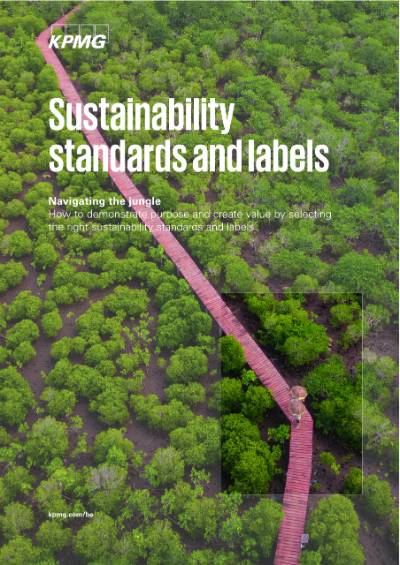Challenging companies on their greenwashing is essential to making a tangible impact and real progress on the social and environmental challenges we are facing. The effort to confront companies has picked up with many facing legal repercussions for greenwashing.
Companies that are making a genuine effort to be more sustainable are worried about facing the same accusations and are choosing to not communicate their efforts. This is known as greenhushing.
How do we strike a balance between capturing audience attention and communicating complex sustainability facts? The proposal for an EU Directive on Green Claims sets out to guide B2Cs in making authentic sustainability claims. Within the Directive, there is a vital section dedicated to sustainability labels which KPMG has conducted research on.
What to expect from this publication
The large number of sustainability and eco labels begs the question how companies should select the right standards and labels that create the most value for them in line with their sustainability strategy goals.
In this paper, we share an overview of the jungle of sustainability standards and labels – and we set out an approach for companies to successfully navigate it.
Key insights
Embedding sustainability in corporate strategy has become more important than ever.
Yet, as the ethical and commercial case for becoming more sustainable increases, so do concerns around greenwashing.
In this context, there is a growing need for companies to be credible when they are "virtue signalling"; sustainability standards and eco labels are a powerful device to do so.
But it’s a jungle out there. There are over 300 sustainability & eco labels with varying scopes.
This makes it difficult for companies to select the right sustainability or eco labels for them, and for consumers to understand what different labels represent.
Label selection should
be directly linked to
a company’s ESG
strategy.
Going through certification consumes time, money and management resources. It is therefore important for firms to carefully choose labels and certificates.
They should think about the standards and labels in the context of their overarching ESG strategy.
We propose a six-dimensional framework to select the right sustainability & eco labels.
- The stakeholder audience being targeted
- The material areas the company wishes to address with the label
- The scope of certification it wishes to obtain
- The rigor of verification of (and effort required to obtain) the label
- Whether the company is looking for sector specificity in the label
- The regional recognition of the sustainability and eco label
How can we help
KPMG firms can support your organization along the entire journey of picking your most appropriate sustainability and eco labels.
Ultimately, every company is unique and has its own sustainability goals. For this reason, KPMG’s advice will always be tailored to your individual case.
In general, however, our practitioners can help your ESG labelling process by:
- assisting you in developing or refining your corporate ESG strategy.
- assisting you in identifying the role of sustainability labels within an existing ESG strategy framework.
- assisting you in selecting the right labels for your specific purpose.
- guiding you through the certification process.
- assisting you in incorporating sustainability labels into your brand positioning.
- assuring disclosures in the annual report.
How can KPMG help your organization in your unique situation? To find out, please contact your local KPMG firm or any of the authors listed at the back of this publication.





